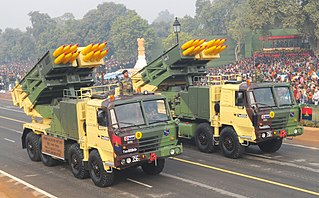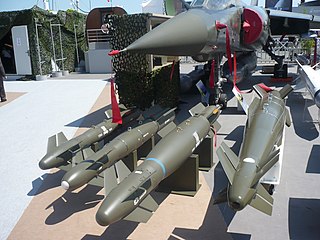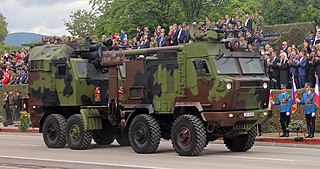Related Research Articles
Draper Laboratory is an American non-profit research and development organization, headquartered in Cambridge, Massachusetts; its official name is The Charles Stark Draper Laboratory, Inc. The laboratory specializes in the design, development, and deployment of advanced technology solutions to problems in national security, space exploration, health care and energy.

The M270 Multiple Launch Rocket System is an American-developed armored, self-propelled, multiple rocket launcher.
A vibrating structure gyroscope, defined by the IEEE as a Coriolis vibratory gyroscope (CVG), is a gyroscope that uses a vibrating structure to determine the rate of rotation. A vibrating structure gyroscope functions much like the halteres of flies.
SAGEM was a French company involved in defense electronics, consumer electronics, and communication systems.

Pinaka is a multiple rocket launcher produced in India and developed by the Defence Research and Development Organisation (DRDO) for the Indian Army. The system has a maximum range of 40 km for Mark-I and 60 km for Mark-I enhanced version, and can fire a salvo of 12 HE rockets in 44 seconds. The system is mounted on a Tatra truck for mobility. Pinaka saw service during the Kargil War, where it was successful in neutralising Pakistani positions on the mountain tops. It has since been inducted into the Indian Army in large numbers.

The M777 howitzer is a British towed 155 mm artillery piece in the howitzer class. It is used by the ground forces of Australia, Canada, Colombia, India, Saudi Arabia, Ukraine, and the United States. It was first used in combat during the US war in Afghanistan.

The L118 light gun is a 105 mm towed howitzer. It was originally designed and produced in England for the British Army in the 1970s. It has since been widely exported. The L119 and the United States Army's M119 are variants that use a different type of ammunition.

The Armement Air-Sol Modulaire, commonly called AASM or HAMMER, is a French precision-guided munition developed by Safran Electronics & Defense. AASM comprises a frontal guidance kit and a rear-mounted range extension kit matched to a dumb bomb. The weapon is modular because it can integrate different types of guidance units and different types of bombs.

The Type 730 is a Chinese seven-barrelled 30 mm Gatling gun/Rotary cannon CIWS. It has a PLA Navy designation H/PJ12. It is mounted in an enclosed automatic turret and directed by radar, and electro-optical tracking systems. The maximum rate of fire is 5800 rd/m, and the effective range is up to 3 km.

The CAmion Équipé d'un Système d'ARtillerie or CAESAR is a French 155 mm, 52-calibre self-propelled howitzer installed on a 6x6 or 8x8 truck chassis that can fire all 39/52 caliber NATO-standard shells. Equipped with an autonomous weapon network incorporating an inertial navigation system and ballistic computer, the CAESAR can notably accurately strike targets more than 40 kilometres (25 mi) away using ERFB ammunition with base bleed, or targets over 55 kilometres (34 mi) away using rocket assisted or smart ammunition.

The Nora B-52 is a 155 mm self-propelled howitzer developed by Military Technical Institute and manufactured by Yugoimport SDPR in Velika Plana, Serbia.

Nirbhay is a long range, all-weather, subsonic cruise missile designed and developed in India by the Aeronautical Development Establishment (ADE) which is under Defence Research and Development Organisation (DRDO). The missile can be launched from multiple platforms and is capable of carrying conventional and nuclear warheads. It is currently deployed in limited numbers in Line of Actual Control (LAC) during standoff with China.

A precision-guided munition is a guided munition intended to precisely hit a specific target, to minimize collateral damage and increase lethality against intended targets. During the First Gulf War guided munitions accounted for only 9% of weapons fired, but accounted for 75% of all successful hits. Despite guided weapons generally being used on more difficult targets, they were still 35 times more likely to destroy their targets per weapon dropped.

An inertial navigation system (INS) is a navigation device that uses motion sensors (accelerometers), rotation sensors (gyroscopes) and a computer to continuously calculate by dead reckoning the position, the orientation, and the velocity of a moving object without the need for external references. Often the inertial sensors are supplemented by a barometric altimeter and sometimes by magnetic sensors (magnetometers) and/or speed measuring devices. INSs are used on mobile robots and on vehicles such as ships, aircraft, submarines, guided missiles, and spacecraft. Other terms used to refer to inertial navigation systems or closely related devices include inertial guidance system, inertial instrument, inertial measurement unit (IMU) and many other variations. Older INS systems generally used an inertial platform as their mounting point to the vehicle and the terms are sometimes considered synonymous.

The error analysis for the Global Positioning System is important for understanding how GPS works, and for knowing what magnitude of error should be expected. The GPS makes corrections for receiver clock errors and other effects but there are still residual errors which are not corrected. GPS receiver position is computed based on data received from the satellites. Errors depend on geometric dilution of precision and the sources listed in the table below.

The SOM is a next-generation autonomous, stealth, high precision cruise missile developed by TÜBİTAK SAGE, Defence Research and Development Institute of Turkey. It was first revealed during the 100th anniversary celebrations of the Turkish Air Force at the Çiğli Air Base in İzmir, on 4 June 2011. Developed since 2006, the SOM is Turkey's first domestic guided missile for striking both stationary and moving targets at a stand-off distance of over 180 kilometers. Although being developed by TÜBİTAK SAGE which still holds authority over the design of the missile, ROKETSAN has been given the role of manufacturing and marketing the missile for export.

The Jang Bogo-class submarine is a variant of the Type 209 diesel-electric attack submarine initially developed by Howaldtswerke-Deutsche Werft (HDW) of Germany, intended for service with the South Korean Navy and Indonesian Navy. A Daewoo (DSME)-upgraded model of the Jang Bogo class Type 209 was exported by Korea to Indonesia in 2012, amid heavy competition from Russian, French, and German-Turkish consortiums including from Germany's original Type 209. The variant was considered for possible purchase by Thailand as well, as both newly built and second-hand options. The class is named for ancient Korean maritime figure Jang Bogo.

The Hemispherical Resonator Gyroscope (HRG), also called wine-glass gyroscope or mushroom gyro, is a compact, low-noise, high-performance angular rate or rotation sensor. An HRG is made using a thin solid-state hemispherical shell, anchored by a thick stem. This shell is driven to a flexural resonance by electrostatic forces generated by electrodes which are deposited directly onto separate fused-quartz structures that surround the shell. The gyroscopic effect is obtained from the inertial property of the flexural standing waves. Although the HRG is a mechanical system, it has no moving parts, and can be very compact.
Safran Electronics & Defense, formerly known as Sagem Défense Sécurité, is a French company specializing in optronics, avionics and electronic systems, as well as software for civil and military applications in the naval, aeronautical and space sectors. It is one of the ten entities that make up the Safran Group.

The Nagapasa class is an upgraded variant of the Jang Bogo class, also known as Improved Chang Bogo. The vessels were built by the South Korean Daewoo Shipbuilding & Marine Engineering (DMSE) and the Indonesian PT PAL. As of 2021, six ships have been planned, which were divided into two batches. Batch 1 consists of three ships and all are already commissioned. Batch 2 also consists of three ships that are in the early development stage. The class is named for weapon of Indrajit, Nagapash.
References
- ↑ "Caesar 155mm Self-Propelled Artillery System". Army Technology. Retrieved 2008-05-26.
- ↑ "India orders SIGMA 95 and SIGMA 30 systems from Sagem Défense Sécurité". Frontier India Defence and Strategic News Service. 2008-02-22. Archived from the original on 2008-11-21. Retrieved 2008-05-23.
- ↑ "Integrated Inertial Positioning Systems, some facts, some editorial and some biased opinions" (PDF). Zupt LLC. Archived from the original (PDF) on 2009-01-06. Retrieved 2008-05-26.
- ↑ "Sagem Unveils the New Artillery Positioning and Pointing System". DefenceTalk. 2008-02-19. Retrieved 2008-05-26.[ dead link ]